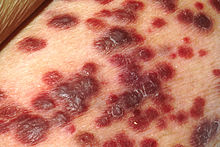Kaposi's sarcoma-associated herpesvirus
| Kaposi's sarcoma-associated herpesvirus | |
|---|---|
 |
|
| Kaposi's sarcoma | |
| Virus classification | |
| Group: | Group I (dsDNA) |
| Order: | Herpesvirales |
| Family: | Herpesviridae |
| Subfamily: | Gammaherpesvirinae |
| Genus: | Rhadinovirus |
| Species: | Human herpesvirus 8 |
Kaposi's sarcoma-associated herpesvirus (KSHV) is the eighth human herpesvirus; its formal name according to the International Committee on Taxonomy of Viruses (ICTV) is HHV-8. Like other herpesviruses, its informal name (KSHV) is used interchangeably with its ICTV name. This virus causes Kaposi's sarcoma, a cancer commonly occurring in AIDS patients, as well as primary effusion lymphoma and some types of multicentric Castleman's disease. It is one of seven currently known human cancer viruses, or oncoviruses.
In 1872, Moritz Kaposi described a blood vessel tumor (originally called "idiopathic multiple pigmented sarcoma of the skin") that has since been eponymously named Kaposi's sarcoma (KS). KS was thought to be an uncommon tumor of Jewish and Mediterranean populations until it was realized that it is actually quite common throughout sub-Saharan Africa. This led to the first suggestions in the 1950s that this tumor might be caused by a virus. With the onset of the AIDS epidemic in the early 1980s, there was a sudden epidemic resurgence of KS affecting primarily gay and bisexual AIDS patients with up to 50% of reported AIDS patients having this tumor—an extraordinary rate of cancer predisposition. Careful analysis of epidemiologic data by Valerie Beral, Thomas Peterman and Harold Jaffe, led these investigators to propose that KS is caused by an unknown sexually transmitted virus that rarely causes tumors unless the host becomes immunosuppressed, as in AIDS.
It was first found by Yuan Chang and Patrick S. Moore, a wife and husband team at Columbia University in 1994, by isolating DNA fragments of a herpesvirus from a Kaposi's sarcoma (KS) tumor in an AIDS patient. As early as 1984, scientists had reported seeing herpesvirus-like structures in KS tumors by electron microscopy. Scientists by then had been searching for the agent causing Kaposi's sarcoma and over 20 agents had been described as the possible cause of KS, including cytomegalovirus and HIV itself. Chang and Moore used representational difference analysis, or RDA, to find KSHV by comparing KS tumor tissue from an AIDS patient to his own unaffected tissue. The idea behind this experiment was that if a virus causes KS, the genomic DNA in the two samples should be precisely identical except for DNA belonging to the virus. In their initial RDA experiment, they isolated two small DNA fragments that represented less than 1% of the actual viral genome. These fragments were similar to but distinct from known herpevirus sequences indicating the presence of a new virus. Starting from these fragments, this research team was then able to sequence the entire genome of the virus less than two years later.
...
Wikipedia
